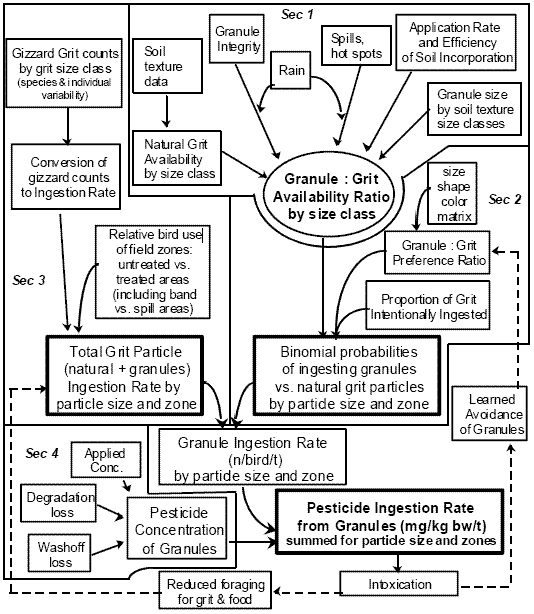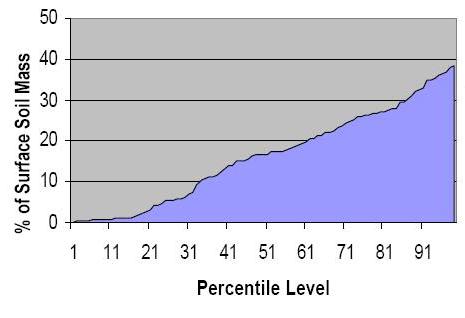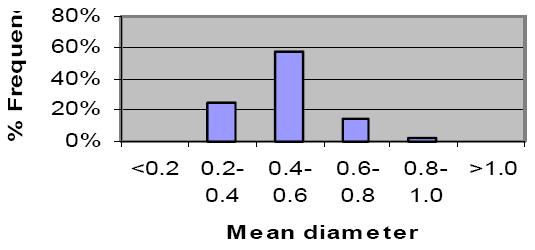Ecological Committee on FIFRA Risk Assessment Methods (ECOFRAM)
Terrestrial Workgroup Report: III. Exposure via Ingestion of Granules
On this Page
- Introduction
- Development of New Tool
- Levels of Refinement in Analysis of Exposure via Granule Ingestion
- How does the model work?
- Examples of Inputs and Outputs
- Literature Cited
Introduction
Of the several ways in which birds and mammals may be exposed to granular pesticides, the ingestion of granules is usually considered to be most important (EPA 1992, Best and Fischer 1992). Granules may be ingested accidentally by animals that obtain food from treated soil or vegetation, or they may be ingested intentionally if they are mistakenly accepted as grit or food.
EPA Office of Pesticide Programs currently uses a hazard index approach (LD50s/ft2) to characterize risk of granular products. The exposure component of this index is an estimate of pesticide load available per an arbitrarily chosen unit area. It is not an estimate of pesticide intake for individual birds, and therefore can not be used in conjunction with the dose-response relationship of acute oral toxicity tests to make predictions about the probability of adverse effects.
Development of New Tool
A new assessment tool is needed that estimates pesticide intake of birds as a result of ingestion of granules. ECOFRAM reviewed two recent attempts to estimate pesticide intake via ingestion of granules using individualbased, probabilistic (Monte Carlo) models (Abt Associates, 1996; Dixon et al. 1997). A Monte Carlo model is under development that incorporates the best features of these models as well as some new ideas.
As a first step, a conceptual model of factors that potentially influence avian ingestion of pesticide granules was developed (Fig 1). The conceptual model has several modular components:
Sec 1 estimates the relative availability of granules and natural grit particles of same size
Sec 2 estimates the probability that a grit particle selected at random by a bird will be a granule
Sec 3 estimates the amount of grit by size and spatial location a bird ingests
Sec 4 estimates the pesticide concentration of granules
Above sections lead to output of pesticide dose ingested
Sublethal exposure may potentially reduce grit intake and cause avoidance (feedback loops)
Fig 1. Conceptual Model of Bird Exposure via Ingestion of Granules

Levels of Refinement in Analysis of Exposure via Granule Ingestion
| Level 1 | Level 2 | Level 3 | |
|---|---|---|---|
| PURPOSE |
|
|
|
Scenario inputs
Scenario inputs Parameter Influencing factors Level 1 Level 2 Level 3 Availability of Natural Grit Particles
(AvlGrt)Soil texture data (% mass by particle size and mineral type) Use reasonable worst-case soil (minimal % sand) for crop type Run model for all major soil texture categories for crop type Randomly choose soil texture data from NRCS soils "pedon" database Availability of Granules
(AvlGnl)Application rate
% left on surface
N & size of hot spots
Rainfall
Granule integrity
Maximum labeled rate
95%tile value from applicable data in literature
Assume 4 in2 spill at end of each row (worst case, expert guess)
No rain
Granules remain intact
Vary rate ± 10% of maximum
Full distribution from studies of similar products and use patterns
Use field data (collect if necessary)
Use conservative estimate of probability of rain each day
Determine how rainfall affects integrity, define granule loss factor
Distribution of rates based on actual use data
Conduct field measurements for the specific product and use pattern
Sample rainfall data from random year for appropriate location
Biology inputs
Biology inputs Parameter Influencing factors Level 1 Level 2 Level 3 Probability of Ingesting a Granule
(ProbGnl)Granule: Grit Preference ratio Assume no preference Use mean estimates of results from lab studies Use full distribution of results from lab studies Particle Ingestion Rate
(PIR)Species chosen for modeling
Amount and size of gizzard grit particles
Turnover rate for gizzard grit particles
Use of treatment site and field zones (treated band, untreated area, hot spots)
Worst-case species (house sparrow)
Mean % use of each size class, 95%tile value for gizzard grit
Use point estimate (e.g. 4.2X per day based on Fischer and Best 1995)
100% of activity on site; Assume exagerated use of hot spots, otherwise proportional use
Evaluate multiple focal species
Sample from actual measurements (e.g., Best and Gionfriddo 1991)
Use full distribution of lab measurements
Reasonable but conservative distributions of site use and hot spots
Distribution based on field measurements
Chemical inputs
Chemical inputs Parameter Influencing factors Level 1 Level 2 Level 3 Pesticide Load per Granule Initial AI Concentration
Degradation rate of AI
Washoff rate for AI
Nominal formulation %
Assume no degradation
Assume no washoff
Field measurement average
Conservative estimate of rate
(pt estimate or distribution)Conservative estimate of rate
(pt estimate or distribution)
Distribution field measurements
Field measurement of rate
(pt estimate or distribution)Field measurement of rate
(pt estimate or distribution)
Analysis outputs
Analysis outputs Parameter Influencing factors Level 1 Level 2 Level 3 Granule Ingestion Rate
(GIR)ProbGnl, PIR 95%tile value from binomial distribution defined by PIR (n) and ProbGnl (p) Distribution of values drawn by Monte Carlo sampling from binomial distribution defined by PIR (n) and ProbGnl (p) Pesticide Ingestion Rate All inputs Conservative point estimate Distribution of values for conservative scenario Distribution of exposure values for multiple, more realistic scenarios
How does the model work?
The user specifies the granular product (e.g. granular fonofos), crop (e.g. corn), geographic region (e.g. Midwest), focal species (e.g. horned lark) and number of model iterations to be run. In each iteration, the grit ingestion behavior of an individual bird at a crop field with a randomly selected soil type within the region is simulated. The number and size distribution of particles an individual bird is "programmed" to ingest each day is determined by sampling from the avian grit use data base of Best and Gionfriddo (1991). Every instance in which a bird ingests a particle is assumed to be a binomial trial in which the particle ingested could be a granule or a natural grit particle depending on their relative abundance and the bird's preference for one or the other. Granule ingestion is estimated by sampling from a binomial distribution defined by the particle ingestion rate (N) and probability of ingesting a granule (p). The daily dose of pesticide ingested (mg/kg BW) is determined from the number of granules ingested and the pesticide load.
| Model Parameter | Definition | How calculated? |
|---|---|---|
| AvlGnlsz | Availability of granules of size s in zone z | From appl. rate, % surface granules remaining, granule size distribution |
| AvlGrtsz | Availability of natural grit of size s in zone z | From soil texture data (% soil mass and mean particle diameter) |
| ProbGnlsz | Probability of ingesting a granule when a particle is ingested of size s in zone z | From relative availability of granules and natural grit particles and granule:grit preference factor |
| ProbGrtsz | Probability of ingesting a natural grit particle when a particle is ingested of size s in zone z | 1 - ProbGnlsz |
| GGP | Granule to Grit Preference ratio | Estimated from literature |
| PIRsz | Particle Ingestion Rate for particles of size s in zone z | From studies of gizzard grit number, size and turnover rate, and relative size and bird use of field zones |
| GIRsz | Granule Ingestion Rate for size s in zone z | Random outcome drawn from a binomial probability distribution based on PIRsz (n trials) and ProbGnlsz (p) |
| PIRG | Pesticide Ingestion Rate from Granules | ∑ GIRsz · GnlWt mg · %AI / BW kg, summed for all particle sizes and zones |
Examples of Inputs and Outputs
Scenario
Availability of Granule-sized Natural Grit in Silt Loam Soils
(from NRCS "Pedon" data base)
Biology
Size of Fonofos Granules

Estimated Number of Grit Particles Ingested per Day by Vesper Sparrows

Analysis
Pesticide Ingestion Rate:
Results of 1000 model iterations
Literature Cited
Best, L.B. and J.P. Gionfriddo. 1991. Characterization of grit use by cornfield birds. Wilson Bull. 103(1):68-82.
Best, L.B. and D. L. Fischer. 1992. Granular insecticides and birds: factors to be considered in understanding exposure and reducing risk. Environ. Toxicol. and Chem. 11:1495-1508.
Abt (Abt Associates Inc.). 1996. Regulatory "cluster analysis" of field corn pesticides. Vols I & II. Report to EPA Office of Policy Analysis. EPA contract nos. 68-W1-0009, 68-D0-0020, 68-W4-0029
Dixon, K., S. Anderson, and M. Hooper. 1997. An individual-based model of chlorpyrifos ingestion and mortality in avian species. Poster PWP058, SETAC Annual Meeting, San Francisco.
Acknowledgment: Special thanks to Pat Havens of Dow AgroSciences for constructing a prototype model.
![[logo] US EPA](../gif/logo_epaseal.gif)